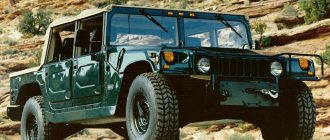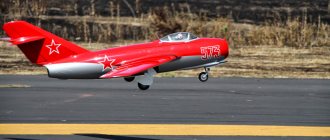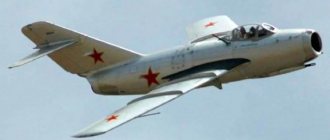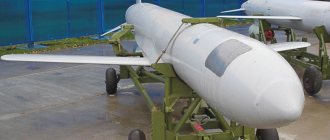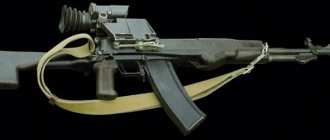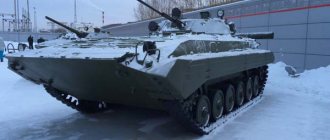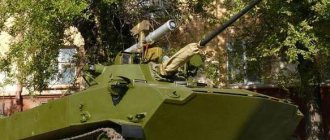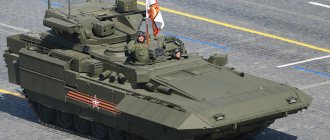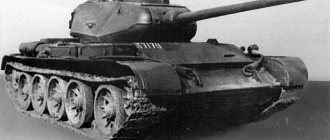The Ministry of Defense has decided to rearm the legendary 4th Guards Tank Kantemirovsky Division, which is stationed near Moscow. The “reactive division” will be reinforced with the most powerful infantry fighting vehicles BMP-3. They have greater firepower and protection than their predecessors, and in addition, they have better driving characteristics. At the same time, in terms of maneuverability, experts note, the new equipment is not inferior to the T-80 tanks with gas turbine engines that are in service with the division.
Shield and beam: infantry fighting vehicles will receive new protection and a powerful laser
The Ministry of Defense agreed to equip the BMP-3 with additional equipment
BMP-3 will receive protection from shells and missiles
Currently, the BMP-3 is the most advanced infantry fighting vehicle in service with the Russian army. Officially put into service in 1987, the combat vehicle still has the potential for modernization and will serve the military for many more decades in the future. Today, the Russian army has more than 500 BMP-3 in service; in addition, the infantry fighting vehicle has been quite actively exported and is in service with the armies of Azerbaijan, Kuwait, Saudi Arabia, Venezuela, Indonesia and other countries.
The main difference between the BMP-3 and most infantry fighting vehicles of other countries is its fairly powerful armament, which is represented by a 100 mm gun/launcher and a 30 mm automatic cannon. In addition, the BMP is armed with three 7.62-mm machine guns, two front-mounted and one PKT machine gun, coaxial with an artillery mount. The second main difference from its competitors is that the vehicle, weighing more than 18 tons, is able to swim, overcoming water obstacles at speeds of up to 10 km/h. Recently, several options for upgrading the BMP-3 have been presented in Russia, including the BMP-3M Dragoon variant. And in mid-August 2022, a representative of the Rostec state corporation announced that the machines were being seriously modernized, primarily by increasing the level of protection, including the installation of active protection systems.
The protection of the BMP-3 will be increased threefold
As Sergei Abramov, who holds the post of industrial director of the cluster of conventional weapons, ammunition and special chemicals of the state corporation Rostec, told RIA Novosti journalists, during the modernization process, Russian BMP-3s are planned to be equipped with new active protection means.
Thanks to an integrated approach, the protection of infantry fighting vehicles is planned to be increased several times. According to a senior Rostec representative, the modernization potential of the latest Russian infantry fighting vehicle adopted for service has not yet been exhausted. In Russia, work is in full swing to create new systems for protecting infantry fighting vehicles from ballistic weapons, which include the SPG-9, which has become widespread throughout the world, and the RPG-7 hand grenade launcher. Currently, Rostec enterprises are working to strengthen the passive protection of the BMP-3, and are also exploring various options for integrating modern active protection systems (KAZ) into the combat vehicle. The active protection complex refers to a type of protection of armored vehicles from various weapons. KAZ is a system that is responsible for detecting ammunition (anti-tank missiles and grenades, as well as shells) approaching a tank or infantry fighting vehicle and countering such ammunition in various ways, from jamming to destroying incoming shells or damaging them and weakening the destructive effect. As Sergei Abramov noted, the use of such systems can increase the survivability of armored vehicles on the battlefield by approximately two to three times.
At the same time, the representative of the state corporation did not specify which KAZ will be installed on the modernized versions of the BMP-3. Theoretically, this could be a modernized Arena complex, which was developed in the USSR back in the 1980s, or a new generation complex, called Afghanit. This active protection complex was specially created for installation on armored vehicles built on the basis of the Armata heavy tracked platform, primarily on the T-14 main battle tank and T-15 infantry fighting vehicle. Individual components of the Afganit complex can be installed on other types of armored vehicles, including the promising Russian Kurganets-25 infantry fighting vehicle.
Modern Russian active protection systems
At one time, the Soviet Union was far ahead in the field of creating active protection systems for armored vehicles.
Soviet engineers began creating the first such systems back in the 1970s, and already in 1983, the world’s first KAZ, called “Drozd,” was put into service in the USSR. It was this active protection complex that became the first in the world to be mass-produced. One of the options for upgrading the BMP-3 could be to install on the combat vehicle a modernized version of the Arena active protection complex, developed back in the late 1980s. This version of the KAZ provides armored vehicles with protection from various types of anti-tank grenades and anti-tank guided missiles; it is also reported that the complex can also hit cumulative projectiles. An export version of this complex has now been created in Russia, designated “Arena-E”. The complex includes a multifunctional radar and defensive ammunition, which are fired towards weapons approaching the tank. Defensive ammunition with narrowly targeted action ensures reliable destruction of missiles, grenades and cumulative projectiles with a beam of destructive elements. At the same time, the complex is all-weather, 24-hour and has excellent noise immunity.
BMP-3 with KAZ "Arena"
Options for installing the KAZ "Arena" on the BMP-3 were undertaken. Back in 2003, a version of the BMP-3M with the installed Arena-E complex was demonstrated in Russia, which made it possible to hit various types of ammunition approaching the combat vehicle. The complex is effective against weapons flying at speeds from 70 to 700 m/s. Since the complex operates fully automatically, its use does not impose any additional burden on the crews of armored combat vehicles.
A more advanced active protection system is Afganit, which was specially designed for installation on armored vehicles based on the Armata heavy tracked platform. At the same time, experts note that there are no serious restrictions that would prevent the installation of the Afghanit complex or its components on armored vehicles of previous generations, including the BMP-3. The only serious obstacle may be the cost of such a complex. A high-tech and complex system is quite expensive and the price can be the factor that will negate any benefits from such a modernization option. So far, “Afganit” could only be seen on “Armata”, “Kurganets” and “Boomerang”, which repeatedly took part in various military parades.
A distinctive feature of the Afganit complex is the presence of an active phased array radar (AFAR), made using the same technology as the radar installed on the Russian fifth-generation fighter Su-57. The AESA radar installed on armored vehicles includes four panels that are placed on the tank's turret, providing a 360-degree view without rotating the turret or rotating the radar. In addition to these elements, the complex includes ultraviolet direction finders for ATGM launches and infrared cameras. At the same time, the active protection installed on T-14 Armata tanks is able to cope not only with modern ATGMs and cumulative grenades, but also allows them to intercept high-speed armor-piercing sub-caliber projectiles (APS). In addition to actively destroying incoming ammunition, the system can activate the deployment of a smoke-metal or aerosol curtain.
Version of the arrangement of Afghanit instruments on the turret of the T-14 tank
At the same time, all KAZ complexes have the same drawback. The damaging elements fired towards the approaching projectile also pose a danger to the infantry surrounding the tank. For example, the developers of the Arena complex noted that the dangerous zone for infantrymen is 20-30 meters near a tank, while such protection does not pose any threat to the tank itself or an infantry fighting vehicle. It is for this reason that armored vehicles equipped with KAZ systems are forced to operate in isolation from infantry formations. It is much easier for tanks to operate in isolation from infantry than for infantry fighting vehicles, which are designed to transport soldiers to the battlefield. Thus, the installation of KAZ on infantry fighting vehicles leads to a revision of the concept of their combat use and use on the battlefield, as well as the subsequent development of such use in exercises at all levels.
BMP-3M "Dragoon"
In 2015, Russian spectators at an exhibition in Nizhny Tagil were presented with two new products from the domestic defense industry - a seriously modernized BMP-3M Dragoon and a self-propelled anti-aircraft artillery mount based on the BMP-3, armed with a new 57-mm automatic cannon.
The ZSU received the designation “Derivation-PVO”. Both new products of the Russian defense industry are of great interest; they are able to extend the life of the BMP-3 for many decades. At the same time, the BMP-3M Dragoon, in fact, is a completely different vehicle. The infantry fighting vehicle has undergone a major overhaul, and we are not just talking about changing the layout of the infantry fighting vehicle. All that remains of the old infantry fighting vehicle is the chassis and hull elements. At the same time, the engine and transmission compartment was moved to the front of the vehicle, which increases the protection of the paratroopers and crew. In fact, only in the Dragoon did Russian designers turn to the classic layout for infantry fighting vehicles from other countries. In addition to additional protection for the landing force and crew members, such a solution improves the process of loading and unloading paratroopers from infantry fighting vehicles due to the appearance of a stern ramp. The full combat crew of the updated BMP model is 11 people, including three crew members.
BMP-3M "Dragoon"
The second noticeable difference of the updated BMP is the completely uninhabited turret, which retains the same armament composition of a 100-mm semi-automatic cannon, a 30-mm automatic cannon and a 7.62-mm PKT machine gun. The unmanned combat module made it possible to place all crew members inside the body of the combat vehicle behind the engine, which increased their protection.
The weight of the combat vehicle, which received improved protection, increased to 21 tons. At the same time, the designers installed a new multi-fuel engine UTD-32 on the Dragoon infantry fighting vehicle, developing a power of 816 hp. This made it possible to achieve excellent specific power indicators - up to 38 hp. per ton, this is much better than most main battle tanks and infantry fighting vehicles around the world. For example, this is almost twice as much as the main American M2 Bradley infantry fighting vehicle. At the same time, the BMP-3M Dragoon is able to accelerate on the highway to speeds exceeding 70 km/h. Despite the increased combat mass, the plump Dragoon retained the ability to swim at speeds of up to 10 km/h.
The combat capabilities of the infantry fighting vehicle have also increased due to the use of a modern fire control system, as well as duplication of crew functions. The workstations of the commander of the combat vehicle and the gunner are completely unified; in addition, the electronic content of the combat vehicle has been replenished with a built-in target tracking machine. At the same time, it can be noted that at none of the exhibitions has the most profound modernization of the BMP-3 at this point in time been demonstrated together with the installed active protection complex.
“Threshka” for “eighties”
BMP-3 will begin to arrive in the “rocket division” next year, Izvestia sources in the military department told Izvestia. Today, the 4th Guards Tank Kantemirovskaya Division includes two tank regiments - the 12th and 13th Guards, as well as the 423rd Guards Motorized Rifle Yampolsky Regiment. Now this regiment, as well as motorized rifle battalions of tank units, are equipped with BMP-2. According to the publication’s interlocutors, it is expected that the latest combat vehicles will first join the 423rd Regiment. In the future, the “three rubles” should strengthen the composition of other divisions of the division.
Earlier, the commander of the formation, Major General Vladimir Zavadsky, said that as part of the state defense order, BMP-3, BTR-82A and other types of weapons would arrive at the formation.
With a new move_1
BTR-82A
Photo: IZVESTIA/Nikolai Sidenkov
Landing on armor: why will the Marines be armed with BMP-3
Each brigade will have a battalion with the latest combat vehicles
Today, the Kantemirovskaya division remains the most powerful military formation west of the Urals. And the only formation in the European direction, which is armed with more than two hundred T-80 tanks with gas turbine engines. Because of this, the troops call it a “reactive division.” Such tanks are capable of moving over rough terrain and off-road at speeds unattainable for any other ground vehicles.
Due to the design features of gas turbine engines, their operation is practically inaudible if you are in front of the tank. Therefore, for the enemy, the T-80 attacking him approaches silently, which has a certain demoralizing effect. But when they pass by, a person hears a hum comparable to an airplane or helicopter. In total, more than 10 thousand “eighties” of various modifications were produced at Soviet factories; the first samples were created at the Kirov plant in Leningrad. Currently, there are 3 thousand T-80BV in army warehouses.
With a new move_2
T-80BV
Photo: IZVESTIA/Alexey Mayshev
The Kantemirovskaya division will become “reactive”
Instead of T-72BZ diesel tanks, the formation will receive T-80BVM turbojet tanks
In recent years, the Ministry of Defense has been following the concept according to which T-80s of various modifications are sent to units and formations in the Far East, as well as in the Arctic - unlike diesel vehicles of the T-72 family, equipment with gas turbine engines is able to start and function even at ultra-low temperatures . The latest modifications of the T-72, as well as the T-90, are supplied to the European theater. With the only exception, the Kantemirovskaya division remains armed with “eighties”. The tank regiments of this formation are equipped with the T-80U modification. And the motorized rifle regiment used to be armed with the T-72. But as Izvestia reported, it is currently planned to be re-equipped with the latest T-80BVM.
The material was published in the magazine "Arsenal of the Fatherland" No. 5(19) for 2015. The course towards creating a new generation of military equipment and weapons, set by the state program for the development of Russian weapons until 2022, today requires from defense industry enterprises not only the accurate implementation of state defense orders, but also the implementation developments on a proactive basis. The mechanical engineering and industrial group Concern Tractor Plants is among those who annually offer new types of military equipment and modernization options for its most popular models.
This is true for all enterprises of the Tractor Plants, representing the military sector, but the absolute leader in new products, of course, has become the Kurgan site of the Concern, which is represented by OJSC Kurganmashzavod, the only manufacturer of infantry fighting vehicles in Russia, and OJSC Special Design Bureau of Mechanical Engineering , the leading Russian design bureau in the design of tracked infantry fighting vehicles.
Over the past few years, a whole line of new types of military equipment has been developed and created in Kurgan. Thus, products for the Russian Airborne Forces - the BMD-4 M airborne combat vehicle, the BTR-MDM multi-purpose tracked armored personnel carrier - passed state tests in 2014, the design documentation for these vehicles was assigned the letter “O1” for organizing mass production. The Ministry of Defense of the Russian Federation is preparing documents on the adoption of these landing vehicles into service with the Russian Army.
Among the newest promising developments of JSC SKBM are infantry fighting vehicles and armored personnel carriers based on the Kurganets 25 unified medium tracked platform. They were first demonstrated this year at the anniversary Victory Parade in Moscow on Red Square. Factory testing of the vehicles will begin soon.
The BMP-3, which has received recognition in the global arms market, remains to this day one of the best combat vehicles in the world in its class. The development and adoption of the BMP-3 by the Soviet Army in 1987 became one of the landmark events in the global development of armored weapons and equipment. Russian designers and industrialists managed to combine excellent mobility, highest firepower and reliable protection in this vehicle. Over the past period, more than a thousand BMP-3 units have been delivered to various countries around the world, including the United Arab Emirates, Kuwait, South Korea, the Republic of Cyprus, Indonesia, Azerbaijan and Venezuela.
And today the modernization potential of the BMP-3 has not been exhausted. At the X International Exhibition of Arms, Military Equipment and Ammunition Russia Arms Expo 2015, which will be held in September in Nizhny Tagil, Tractor Plants will present their premiere developments - prototypes of the Dragoon and Derivation on the units and assemblies of the BMP-3, and also BMP-3 with an upgraded Vityaz fire control system.
"Concern "Tractor Plants" Machine-building and industrial group, whose enterprises are managed by LLC "Corporate Management Company" Concern "Tractor Plants", is one of the largest Russian integrators of scientific, technical, production, technological and financial resources in mechanical engineering, as in Russia , and abroad.
Since 2006, the group has included 17 systemically important production enterprises, employing more than 20 thousand people from 10 constituent entities of the Russian Federation, as well as foreign and neighboring countries, 4 specialized engineering and 3 trade and service companies.
The created vertically integrated production model allows Tractor Plants to provide the full life cycle of its products - from research and development, production of metals and spare parts to marketing and sales operations, as well as after-sales service.
BMP-3 infantry fighting vehicle with an upgraded Vityaz fire control system
To increase firepower, the BMP-3 infantry fighting vehicle can be equipped with a modern 24-hour digital fire control system “Vityaz”, which provides effective weapon control.
Its advantages:
- the time to prepare a shot is reduced, thus implementing the principle of “seen earlier, fired earlier”;
- the survivability of the combat vehicle is increased due to the duplication of functions at the commander’s and gunner’s workplaces, and there is a high-quality unification of workplaces;
- the safety of the crew's work is increased with the ability to remotely control the weapons of the combat vehicle;
- work from closed positions is ensured;
- shooting at low-flying air attack weapons is ensured.
BMP-3 Dragoon infantry fighting vehicle
The BMP-3 Dragoon infantry fighting vehicle with an unmanned combat module and a front-mounted engine compartment has the following advantages compared to the mass-produced BMP-3:
- Placing the MTO in the front of the vehicle significantly increases the protection of the combat crew from conventional enemy weapons;
- Placing troops in the rear of the vehicle and the presence of a ramp improves the conditions for dismounting and loading troops when the vehicle is moving at speeds of up to 5 km/h;
- The use of an unmanned combat module increases the protection of the combat crew (the commander and operator-gunner are located in the manned compartment of the chassis);
- The use of a more powerful UTD-32 engine makes it possible to increase armor resistance and mine protection while maintaining the mobility of the vehicle at the level of the BMP-3;
- Placing fuel tanks at the stern increases fire safety;
- The use of the modern Vityaz fire control system increases firepower;
- Placing the MTO in the front part of the chassis frees up significant space for various equipment (both stationary and portable using a ramp) when using the chassis for machines for various purposes.
| Technical characteristics of the BMP-3 infantry fighting vehicle with the Dragoon combat module | |
| Total information | |
| Type | Tracked, armored, floating, air transportable |
| Total combat weight, t | 21,0+2 % |
| Number of combat crew members (crew and troops), people. | 11 |
| dimensions | |
| Length, mm, no more overall with 100 mm gun forward overall with 100 mm gun rear along the body | 7950 8420 6715 |
| Maximum height on the roof of the tower, mm | 2570 |
| Maximum height of non-removable parts of the tower, mm | 3020 |
| Ground clearance, mm, not less | 450 |
| Travel speeds | |
| Maximum speed on the highway, km/h: forward back | 70 20 |
| Maximum speed afloat in calm water, km/h | 10 |
| Engine | |
| Brand | UTD-32 |
| Power (bench) at 2600 rpm, kW (hp) | 600 (816) |
| Weapon complex | |
| Weapon - launcher | |
| Brand | 2A70 |
| Type | rifled semi-automatic |
| Caliber, mm | 100 |
| Firing range 100 mm shots ZUBK23-3 ATGM shots | 7000 100–5500 |
| Automatic gun | |
| Brand | 2A72 |
| Type | automatic |
| Caliber, mm | 30 |
| Rate of fire, rds/min, not less | 300 |
| Firing range with 30 mm cartridges, m: OFZ, OT BT | 4000 2500 |
| Machine gun | |
| Brand | PKTM |
| Type | tank |
| Caliber, mm | 7,62 |
| Firing range, m | 2000 |
| Rate of fire, rds/min, no more | 250 |
| Ammunition | |
| Rounds for the 2A70 gun (in the loading mechanism conveyor), pcs. | 22 |
| Cartridges for the 2A72 gun, pcs.: | 500 |
| 7.62 mm cartridges for the PKTM machine gun, pcs. | 2000 |
| 100 mm ATGM rounds, pcs. | 8 |
| Additional ammunition in non-mechanized stowage | 18 rounds for the 2A70 gun or 250 rounds for the 2A72 gun (not taken into account in the combat weight of the vehicle) |
| Number of smoke grenades 3D6M systems 902B, pcs. | 6 |
| Fire control system | |
| Type | automated digital, with a unified information environment, 24/7, noise-proof, with the ability to automatically track ground and air targets and fire from closed positions, with registration of system operating parameters and crew actions |
| Gunner's sight (duplicate) | |
| Brand | PPB-2 |
| Type | monocular, periscopic |
| Sight of the commander, gunner | |
| Brand | "Merlin" |
| Type | unified, panoramic, day-night, with independent two-plane field of view stabilization and automatic drift compensation, with television, thermal imaging and rangefinder channels |
| ATGM control channel block | |
| Brand | "Dawn" |
| Type | electronic digital formation of the control field with independent two-plane stabilization of sighting and automatic compensation of drifts |
BMP-3 infantry fighting vehicle with a 57-mm automatic cannon (“Derivation”)
The BMP-3 with an unmanned 57-mm automatic artillery mount is a tracked combat vehicle with powerful weapons, armor protection and high maneuverability. The purpose is to increase the mobility and armament of infantry operating in modern combat conditions.
The BMP-3 with a 57-mm automatic artillery cannon allows you to effectively hit enemy personnel, including those wearing personal armor; tank-dangerous manpower; lightly armored combat vehicles; modern models of infantry fighting vehicles; unmanned aerial vehicles; low-flying airplanes and helicopters.
| Technical characteristics of the BMP-3 infantry fighting vehicle with a 57-mm automatic cannon (“Derivation”) | |
| Total information | |
| Type | Tracked, armored, floating, air transportable |
| Total combat weight, t | 19,3+2 % |
| Number of combat crew members (crew and troops), people. | 10+2 (additional seats) |
| dimensions | |
| Length, mm, no more along the body | 6715 |
| Width, mm, no more: by tracks | 3150 |
| Maximum sight height, mm | 3155 |
| Ground clearance, mm, not less | 450 |
| Travel speeds | |
| Maximum speed on the highway, km/h: forward back | 70 20 |
| Maximum speed afloat in calm water, km/h | 10 |
| Fuel range on the highway, km, no less on a dirt road, h, no less afloat, h, no less | 600 12 7 |
| Engine | |
| Brand | UTD-29 |
| Power (bench) at 2600 rpm, kW (hp) | 368 (500) |
| Transmission | |
| Type | hydromechanical, four-speed, with power take-off to water-jet propulsors and on/off of water-jet propulsors in any gear |
| Suspension | |
| Type | independent, misaligned, torsion bar |
| Weapon complex | |
| A gun | |
| Type | automatic |
| Caliber, mm | 57 |
| Rate of fire, rds/min, not less | 80…100 |
| Aimed firing range, m: | 8000 |
| Vertical/horizontal guidance angles, degrees | –5…+60/360 |
| Machine gun | |
| Brand | PKTM |
| Type | tank |
| Caliber, mm | 7,62 |
| Firing range, m | 2000 |
| Rate of fire, rds/min, no more | 250 |
| Nutrition | tape |
| Vertical/horizontal guidance angles, degrees | –5…+60/360 |
| Ammunition | |
| Shots for the cannon (ready to fire/total in a combat vehicle), pcs. | 80/150…200 |
| 7.62 mm cartridges for the PKTM machine gun (ready to fire/common in a combat vehicle) pcs. | 1000/2000 |
| Fire control system | |
| Structural composition | Commander's sight. Gunner's sight. Central computing system Unit for converting and switching video and control signals with a fiber-optic video transmission system Complex of topographical reference, navigation and orientation Stabilized weapon block guidance system Complex of communication and data transmission facilities Mechanism control and shooting complex |
| Commander's Sight | |
| Type | Panoramic (360°), optical-electronic, including television, thermal imaging, laser rangefinder channels, laser beam control channel, video path formation system, alignment system, stabilized guidance system. |
| Gunner's sight | Similar to the commander’s sight with the autonomous horizontal guidance sector limited to –90°…+45°. There are no overview (30°) TV and TPV channels. |
| Workplaces for gunner and commander | |
| Type | With control panels and operational control panels, with a documentation and control system. |
Machine-building and industrial group "Concern "Tractor Plants" 428022, Russia, Cheboksary, Mira Ave., 1 +7 (8352) 30–42–27, +7 (8352) 30–42–28 e-mail: This address email is protected from spam bots. You must have JavaScript enabled to view it., www.tplants.com
OJSC "Kurganmashzavod" 641027, Russia, Kurgan, Mashinostroiteley Ave., 17 +7 (3522) 47–14–40, fax: +7 (3522) 23–20–82, e-mail: This email address is being protected from spam -bots. You must have JavaScript enabled to view., www.kmz.ru
LikeLikeTweet
